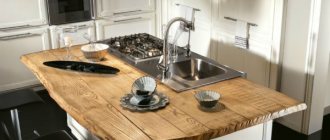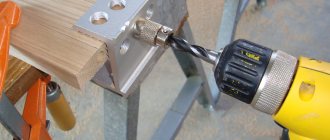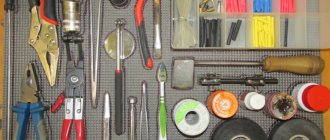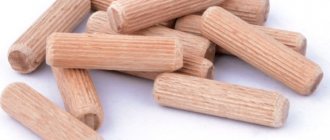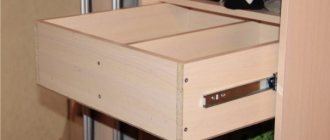Features of application in the furniture industry
Conductors and templates are needed when assembling furniture. These things will prevent you from having a common problem that occurs during drilling—the drill hitting the part at the wrong angle. Correcting such an error will take an extremely long time, in some cases it will even be impossible.
A jig for making holes will not only allow you to correctly orient the working tool, but will also prevent it from straying from the desired trajectory.
In the furniture industry, jigs and templates are used in the following cases:
- in mass production;
- when assembling structures, when it is necessary to make holes for fasteners in the parts being connected. In this case, a jig for drilling holes for dowels or confirmat is suitable;
- a jig for drilling holes at an angle is used both in such cases and when working with thin boards, for example, MDF or chipboard.
When using such a device, the assembly process will be much easier and faster; you will be able to make the necessary holes regardless of how far they should be located from the edge of the part and how wide it is.
When assembling furniture yourself, you often have to connect parts end-to-end using dowels. Holes for dowels are best made using a special jig. The peculiarity of dowels is that despite the fact that such fasteners, although outdated, are still relevant in furniture production.
The difficulty in their use lies in the fact that the axes of the holes that are made in the parts when connecting must have a right angle with each other. Accordingly, they must be placed strictly perpendicular to each other. It is difficult to do this without a special device. Therefore, if you want to achieve high quality performance, it is recommended to buy a dowel jig.
Description
Despite the fact that fastening options are different, dowels are most often chosen from wood.
For this purpose, hardwood forest is used, often birch. Sometimes reinforcement or pipes are used in construction, but the fact is that metal is too hard a material, and it does not give the natural shrinkage that a wooden dowel can give. It allows more flexibility for the walls.
In addition, the wood is not subject to rust, and even when wet it does not deteriorate, but rather provides better adhesion to the neighboring material.
Under no circumstances should you use screws or nails. They will only worsen the entire structure
The dowel is made slightly shorter than the hole drilled in the beams and of a slightly smaller diameter so that shrinkage occurs more evenly.
This design captures two beams at once and is installed around the perimeter in a checkerboard pattern.
Other uses
Hole jigs are used not only in furniture production. Quite often they are used when you need to make a hole in a pipe or other cylindrical part. Thanks to them, you can make a high-quality hole even in a pipe with a small diameter.
Such devices are universal and easy to use, so they are also used in the following industries:
- mechanical engineering - drilling holes in different-sized workpieces based on different materials;
- construction - drilling holes in building structures;
- home communications - as already mentioned, pipe drilling and more.
Modern drilling jigs can be of different sizes and have different operating principles. Some of them are complex, so they are easier to buy. And some modifications can be made independently, especially since some serial furniture models, especially those with universal purposes, are expensive.
Benefits of use
Essentially, such a jig acts as a template for making holes so that they are made as accurately as possible. They can be used for those holes whose axis is perpendicular to the surface of the workpiece, as well as for working at an angle.
This tool is an excellent alternative to sketches and manual measurements. You can place the drill strictly at the desired angle in relation to the workpiece and will not allow any deviation. The result will be especially noticeable when it comes to making deep holes.
If you use such a high-quality device for working with chipboard, then it should have the following characteristics:
- facilitate quick assembly of furniture without the need to use complex tools;
- make it possible to make several holes simultaneously without manual marking;
- significantly improve the quality of work with the drill.
Conductors are made from different materials; there are models based on plastic or organic glass. However, the best option is considered to be made of steel , which has such advantages as:
- minimal likelihood of deformation;
- the drill is directed as clearly as possible;
- no heating during operation.
Very often, overhead models based on lightweight materials that are easy to manipulate are used as furniture jigs. Many people use factory or homemade tools.
And the most qualified and experienced craftsmen no longer use a jig, since they can easily make a hole in structures on their own as accurately as possible. But not everyone can do this.
Read also: Shovel for concrete hammer drill
The key advantage of such a device is that the work can be performed as accurately and efficiently as possible, even by a person who does not have the proper experience. You don't have to do markings and complex preliminary calculations. You will save a lot of time and produce furniture much faster.
What are wooden dowels?
First, it’s worth understanding what the dowel itself is. The part is a miniature fragment made to strengthen the walls of a log house made of timber. In this case, it is the diameter of the dowels for the timber that acts as one of the most key characteristics.
The purpose of the dowels may be different. For example, wooden dowels are aimed at fixing log structures. The detail allows you to slow down a variety of negative consequences that invariably accompany the functioning of wooden structures. It could be:
- drying out;
- deformation;
- loosening;
- bias.
Such peculiar pins, installed correctly and correctly, will make the building stable. The beams of the structure will be placed in such a way that they will remain unchanged after a couple of months and after several decades.
Classification of tools
Before you buy a ready-made conductor or make it yourself, you need to decide what problems you will solve with its help and only then you need to select the appropriate option in terms of design and functions.
There are a number of categories of devices that differ in their design and functional features. Here are some of them:
- overhead - such devices are applied to a part that can be processed, then it is attached to it or simply fixed manually. With their help, holes are made in various flat parts, MDF boards or chipboard;
- rotary - these templates are used when processing cylindrical parts. They are equipped with horizontal and vertical axes of rotation, so holes can be made at different angles;
- universal - such devices are suitable for small serial furniture manufacturers, where sometimes quick readjustment of the equipment used is required, they have all the functions necessary for this;
- tiltable - used when the technological procedure is carried out in several planes at once;
- sliding - such conductors do not need to be attached. Simply attach them to the surface area of the workpiece where you want to make a hole;
- fixed - they are more convenient to use, but they limit freedom of action, which is very critical when working with machines where there is only one spindle.
DIY jig for drilling holes
As already mentioned, depending on the scope of use and design, you can make some options yourself, thanks to which you will save a significant amount.
Before work, find the required drawing of the device and make everything strictly according to it.
Tools required for work:
- welding machine;
- Bulgarian;
- drill;
- locksmith supplies.
To make the simplest version of the conductor with your own hands, we perform the following steps:
- take reinforcement measuring 10 by 10 mm with a square cross-section;
- cut a piece of the required length and sand it with sandpaper;
- make markings for the template holes. In this case, it is not allowed for the center to approach the edge by more than 8 mm, this is almost half the thickness of the chipboard sheet. Also, according to the standards, a distance of 32 mm must be maintained between centers;
- after marking the centers, make holes in them 5 mm in diameter;
- to make an emphasis, take a metal plate 2.5 mm wide and 1 mm thick. Bend it at an angle of 90 degrees, and then, together with a piece of prepared reinforcement and fastening in a clamp, make a place for the thread;
- cut the thread and connect the two parts into one structure. The device is ready.
As you can see, such a device is very simple to make yourself, but it will greatly simplify your work if you are making furniture. If you are doing this exclusively as an amateur, then this option will be sufficient. If you can’t do it yourself, buy a ready-made option, perhaps the simplest and most inexpensive.
But professional equipment will cost much more; it makes sense to purchase it even when we are talking about at least small-scale mass production. But with its help you can easily and quickly connect pieces of furniture or repair it.
So, you have learned what a hole jig is and how it helps in furniture production. This device can be purchased ready-made or made by yourself.
Houses made of natural wood have now regained popularity. But wood is far from a homogeneous material, therefore, during the shrinkage process, slight deformation occurs; different parts of the house take on their final appearance unevenly.
This raises the problem of fastening the beams together, which will ensure reliability, on the one hand, and uniform shrinkage, on the other. The solution was found a long time ago - dowels. The element differs in size, cross-sectional shape (circle or square), and material of manufacture.
Types of dowels
There are many types of fasteners, but they are conventionally divided into groups according to material and shape. Let's consider this issue in more detail.
Material of manufacture
Two types are actively used:
- Wood. Most experts strongly recommend using a wooden tenon when constructing wooden structures. The main advantages when choosing such fasteners are given:
- Even drying. The beam and dowel should be approximately the same humidity. This will allow the shrinkage process to go through with virtually no visible changes;
- Not affected by temperature changes . The tree practically does not change its linear dimensions at different temperatures, so the fastening element will always be in place;
- No rust . Metal rusts over time, which leads to rotting of wooden surfaces in contact with it;
- There is no condensation. With a sharp change in temperature, moisture forms on steel, which is completely useless inside a load-bearing wall.
- The dowel fuses with the wall. After a certain time, the house will become monolithic, the wooden surfaces will be soldered together.
- Metal. This option also applies to a budget fastening method; waste materials (pipes, fittings) are often used. Although experts prefer the previous method, the metal dowel has its advantages:
- The top layers of wood are protected from torsion;
- Durability of the structure.
Read also: GOST for welding stainless steel in argon
Form
There are also several main forms:
- Round section. Taking into account the fact that the holes for fastening in the log are made with a drill, the round dowel will provide the maximum contact area, guaranteeing the reliability and durability of the structure;
- Square. It is easier to make such an element; it also costs less. But that's where the positives end. When entering the hole, the edges of the tenon are deformed, and the total contact area remains minimal. Building a house this way is dangerous;
- Narrow rectangle . The easiest option to manufacture. A board of a certain thickness is taken and cut into rectangles. The only advantage is the very small thickness. Suitable for narrow timber, but installation is extremely difficult.
We make the dowel with our own hands
This type of fastener is sold in stores, but you can make it at home without much difficulty. The wooden element is made as follows:
- scraps of boards are taken, from which beams measuring 25 by 25 centimeters are cut;
- stakes are made 1.5 times the thickness of the building timber, with a diameter of 2.5 centimeters;
- The corners are cut off with an ax to give a rounded shape.
But the following must be taken into account:
- the wood for fastening must be harder than timber. Nowadays birch is most often used for these purposes;
- the dowel should not differ significantly in humidity from the main structural element;
- It is strictly forbidden to use a dowel with a knot.
Making dowels
- If necessary, you can turn them yourself on a lathe from premium or first grade wood.
- Please make sure that it is without a lot of knots and damage.
- Do not make dowels from hygroscopic material.
- The diameter of this rod must be greater than 2.5 cm.
- The length can be arbitrary, from 1.5 to 2 meters, in any case only part of the product is used.
We invite you to familiarize yourself with Roof pipe for a stove
To make dowels, you need a lathe and cutters of the required configuration. After which a suitable material is selected.
Manufacturing process:
- The workpiece of the required diameter and size is selected.
- Attached to the machine.
- Using a cutter, the desired rounded shape is given.
- It is necessary to constantly measure the diameter of the workpiece being turned with a caliper so as not to remove excess material.
- The workpiece is cut to length and chamfered.
- We repeat the same action with the other part.
You can make it even simpler - cut the board on a sawmill into thin blocks measuring 25x25 mm. Then use square dowels for construction.
We carry out calculations
Depending on the chosen fastening technology, it is possible to determine with sufficient accuracy the number of dowels and calculate their correct characteristics.
Deciding on the sizes
There are many scientific works that will help determine the diameter of the dowel. But in the professional environment of carpenters and builders, certain rules have already been formed:
- for timber with a thickness of 20 centimeters or less, a dowel with a diameter of 25 millimeters is used;
- a thicker beam is fastened with a tenon measuring 3 centimeters;
- timber thicker than 0.2 meters can be fastened with a 2.5 cm dowel, but subject to the step being reduced to a meter.
Counting the quantity
Even a small sauna will require quite a large number of spikes that need to be purchased or made, which can take a long time. Therefore, it is better to know the number of fasteners in advance.
There are fastening rules:
- the first dowel is inserted at a distance of 20 to 70 centimeters to the corner;
- the step is from one and a half to 2 meters;
- It is necessary to fasten two adjacent logs in height.
Knowing these tricks, the height of the structure, the diameter of the timber, you can easily calculate the number of dowels needed for construction.
Varieties and sizes
Dowels come in wood and plastic. The latter are rarely used, but can still be found in stores. In cases where maximum strength is required, metal dowels can be used, but this happens even less frequently.
Wooden dowels can be divided into five main types depending on the notch:
- with a straight vertical texture. They are used everywhere and are the most affordable type of such fasteners;
- with a helical texture. Pins of this type are protected from loosening by means of a notch located at an angle from the vertical axis;
- with a complex texture. It has both transverse and longitudinal notches, allowing you to reliably hold structures subject to high loads;
- with horizontal texture. It is used for final assembly, as it creates a tight, often permanent connection;
- without invoice. Designed to protect against shear, usually used only with the horizontal joining method.
In this case, dowels are those fasteners that can be used to assemble vertical elements, that is, they have high tenacity and create a permanent connection. These, for example, include dowels with horizontal and complex textures.
Depending on the thickness of the material, the size of the dowels also varies. On the open market you can find dowels with a diameter of 4 to 30 mm, with a length of 15 to 200 mm. A correctly made dowel has no flaws and is resistant to temperature and other influences.
Fastening technology
Drilling
A powerful drill is used if it is necessary to make holes directly on the construction site, or a machine if the timber is prepared in advance.
The second method is common in the West and allows you to assemble the structure of almost any house in a few days. But it requires attentiveness, accurate drawing, and professionalism.
The diameter of the drill and the thickness of the dowel must match, and for the upper tiers of the timber the hole should be even two millimeters larger. This eliminates sagging of the supporting structure due to a small vertical load. The hole is made 2 centimeters longer than necessary so that the tenon can move smoothly during shrinkage.
Clogging
Typically a sledgehammer weighing several kilograms is used. The dowel is driven inward below the edge of the beam to the end of the hole; nozzles (usually made of brass) are used for this.
Correct location
The ideal option is when the dowels are arranged in a checkerboard pattern. But a strictly vertical direction along parallel lines is also allowed and does not significantly affect the strength.
A gap of at least thirty centimeters before the start of the opening is recommended. The distance of the fastener to the corner should not exceed 70 centimeters. The step can vary from a meter to 3, depending on the material from which the timber is made (hard varieties require a smaller step).
How to install correctly (drilling and fastening)
The number of fasteners is calculated based on the principle of 2 meters between each subsequent fastening.
We suggest that you familiarize yourself with the distance between buildings on adjacent plots
To secure the timber with dowels you need to:
- Drill a hole along the diameter of the fastener to a depth of 1.5 times the size of the timber.
- The dowel should be 30 or 40 mm shorter than the depth; it is driven into this hole by 10 mm. A distance of 30 mm in the lower of the two beams will be needed for possible shrinkage so that the beam does not hang.
- We hammer in a checkerboard pattern, the distance is from 1 thousand to 1.5 mm.
- The distance from openings or bowls must be at least 300 mm.
- The moisture content of the fasteners should best be the same as the wall material.
Advantages and disadvantages
Like any other fastening element, the dowel has a number of positive aspects, as well as disadvantages.
Advantages:
- The spike provides reliable grip and prevents the crown from sagging;
- Provides long-term reliability under bending loads, which nails and bolts cannot boast of;
- Promotes uniform shrinkage of the house. The fastening element moves freely along a vertical plane, preventing horizontal deformations;
- The wooden product is not subject to the formation of moisture and corrosion, excluding the process of rotting;
- Extremely cheap. Even buying ready-made dowels won’t put a big dent in your pocket, allowing you to minimize your budget.
Read also: LCD TV
But there are also disadvantages:
- Difficult to install. Absolute vertical position, ideal selection of diameter, implies the presence of decent construction skills;
- Serious quality requirements. The presence of knots or heterogeneity of the material can lead to disastrous consequences;
- Excessive force when driving often leads to cracks in the timber. After which it needs to be changed.
How to use dowels when building a house from timber
- The dowel must not be hammered in completely to prevent cracks in the timber.
- The holes in the upper crown for fasteners should be slightly wider, this will prevent the beam from sagging.
- The pin itself must fit into the hole freely; this is necessary for the wood to shrink.
- The holes for them are drilled perpendicular to the surface and located along the axis of the beam.
- The distance between the pin fastenings is calculated according to the construction documentation.
Advantages of fasteners:
- Reliable grip and structural integrity.
- Ability to resist shrinkage and natural phenomena.
- Long service life of the house.
- Minimizing gaps between timber.
Dowels, like other fasteners, have their advantages and disadvantages.
The advantages include:
- The dowel prevents the crowns from sagging.
- It does not corrode like metal.
- They are more suitable for the construction of a residential building than for a log house for a country house.
- They work better in bending than nails or reinforcement.
However, there are also disadvantages:
- The assembly of the log house will be slower.
- An incorrect selection of sections will not ensure the strength of the structure, and a larger one can lead to the destruction of the timber.
- Without the proper skills, it is difficult to work with dowels; it is difficult to align the fastener with the hole; the help of 2-3 people is required.
- A lot depends on the quality of the product itself, which must be knot-free, impregnated and non-hygroscopic.
Professionals work best with this fastener; single craftsmen are better off using metal.
Blitz tips
There is a set of installation tricks that will allow you to build your dream home that will last for many years:
- Chess order. The condition is not mandatory, but highly recommended by carpenters of all stripes;
- To avoid sagging, it is necessary to use round-shaped wooden dowels. Square products are mainly promoted by manufacturers as they are easier to manufacture;
- When clogging, you can and should reduce friction. To do this, it is enough to use a soap solution;
- It is recommended to use birch fasteners. This guarantees the reliability of the structure, gives a certain charm, and does not increase the cost of construction;
- Similar humidity between the tenon and the beam is a fundamental condition for the durability of the structure. You need to pay close attention to this;
- Feel free to use additional fasteners. Science does not stand still; modern devices can make the task much easier.
Learn to cope with three main problems that are guaranteed to allow you to achieve success when working with any conductor device.
Using round dowels you can significantly increase the strength of many joints. But this seemingly simple method is not forgiving: the connection cannot be assembled if one of the holes is misaligned. It doesn’t matter how much it is shifted - just half a millimeter or a whole meter - the result will be the same. To avoid such confusion, we will show solutions to three common problems that arise when working with dowels.
But first, remember the important rules that will help you achieve accuracy when making such connections.
- For marking, use a sharp pencil or knife. A pencil with a thick lead will not allow you to make marks with the required accuracy.
- For drilling, use drills with a center point. Conventional twist drills with conical sharpening often deviate from the desired direction when drilling into the edge or end of a part.
- To ensure that the holes have the same depth, place a locking ring on the drill and secure it firmly. The depth of the hole should be 2-3 mm more than half the length of the dowel.
Place cross marks on one side of the drill jig and the face of each piece to avoid confusion when orienting the fixture.
Problem No. 1. The edge-to-edge connection can be assembled, but the planes of the parts do not coincide.
Solution. Most likely, the holes in the guide bushings of the drill jig are not aligned with the center of the edges of the parts. Always orient the fixture along the reference planes of both parts (picture on the right). Then, even if the holes are not located in the middle of the thickness of the boards, there will be no sagging or shifting in the connection.
Problem #2: The holes drilled in one part do not line up with the matching holes in another.
Solution. To ensure that the holes match, instead of marking, use special markers for the connections on the dowels. First, use a drill jig to make all the holes in one of the two adjacent pieces. Then insert a marker into each hole and press both parts together with clamps. The small prick marks left by the tips of the markers will indicate where the counter holes need to be drilled. Position the drill jig exactly above the mark and drill a hole as shown in the photo on the right.
Before going to the store, don't forget to put a caliper in your pocket. Measure the diameter of the dowels to ensure they fit your project.
Problem #3. The holes are made correctly, but the dowels do not fit into them or fall out.
Solution. Make sure that the diameter of the dowels matches the diameter of the holes. Mass-produced commercial dowels may be larger or smaller than the nominal diameter and, like most pieces of wood, will swell or shrink with changes in humidity. If the dowels are the correct diameter, the guide bushings on your drill jig may be worn, causing the drill to deviate, resulting in irregularly shaped holes. Replace worn bushings, and if this is not possible, then buy a new device.
For accurate marking, do not rush to tighten the clamps completely. When the tips of the markers lightly touch the adjacent piece, align the edges and ends exactly, and then tighten the clamps.
Insert the drill bit with the center point into the jig and point it at the point made with the marker. Hold the drill bit in place, secure the jig to the piece, and then drill the hole.
Tips and tricks
- Nails, screws and other metal will spoil the wood from the inside, so if possible, it is better to use wood. Otherwise, due to the different thermal conductivity of the materials, condensation accumulates, and this leads to rust on the fittings and rotting of the wood. It’s not for nothing that ancient ships were built entirely of wood, and examples of architecture speak of the same thing. The temple in Kizhi, built without a single nail, has stood for many centuries, and, nevertheless, is still just as strong.
- Don’t forget about the staggered order of installing the dowels; this is why you need a house design to calculate not only the number of fasteners, but also the location of its installation.
- To avoid hanging logs and the entire structure of the house, it is better not to use metal and square wooden dowels. Experienced craftsmen advise using a standard round fastening structure made of birch. This will allow you to achieve not only strength, but also the beauty of the building as a whole.
- In addition to dowels, for uniform shrinkage of the log house, you can use such structures as: screw jacks and sliding fastening of metal rafters.
- The moisture content of the fasteners must match the moisture content of the timber.
- To reduce friction when driving the rods, professionals use a soap solution.
Building a house yourself is a rather difficult and important stage. However, if you take your time and do everything according to the recommendations, you can completely cope with this.
We invite you to familiarize yourself with Buleryan stoves: design and principle of operation, how to install and how to heat
If such work seems too labor-intensive, then it makes sense to turn to professional construction companies specializing in the construction of wooden houses. They will help you build a house quickly and competently, and will also be able to guarantee that it will be completed in accordance with all necessary standards.


